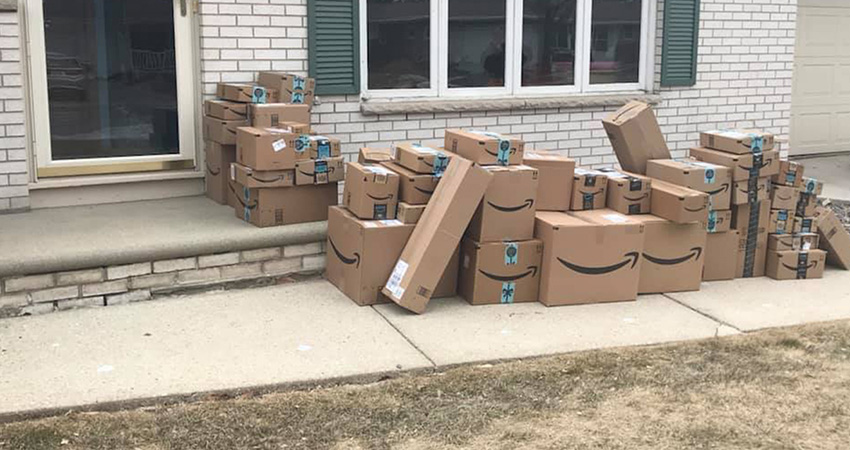The growth in boxless packaging at Amazon may prevent this scenario in the future (credit: WFLA.com)
Amazon has been quietly growing the volume of orders going out boxless, which the company says represented 11% of items shipped in 2022, a move that some believe signals a sea change in the pursuit of reducing ecommerce packaging materials that will be imitated widely across retail.
“The recognition by a number of senior leaders was just that this is becoming more and more important,” Pat Lindner, Amazon’s first-ever vice president of packaging and innovation, told the Wall Street Journal. “There’s a significant need for our company to take the next step in innovation around packaging.”
Now the Default
Amazon customers can choose to add an external “smiley” box at checkout, but boxless is now the default, and more apparently are opting for it. This trend is helping Amazon reduce its logistics costs and improve its sustainability profile.
While “ships in its own container” can improve branding for retailers but reduce it for Amazon, it can also be more inviting for porch pirates who snatch items, sometimes following delivery trucks around neighborhoods. SafeWise estimates 260 million delivered packages were stolen in the U.S. in 2022, up from 210 million the year before. And who knew there was an element of psychology involved in porch piracy, in terms of how dopamine triggers work?
That aside, this trend presents more challenges for shippers who need to ensure that their ecommerce packaging is sufficient to protect sensitive items from all the bumps, shocks and touches that happen along the journey.
Move Seen as Positive
Experts applauded the move by Amazon in terms of the improved economics for the company, the customer experience and the environment from reducing packaging waste.
Marc Wulfraat, president of supply chain consultancy MWPVL International, said boxless shipping presents numerous challenges for Amazon, including theft, damage, customer embarrassment and defacing of packaging. Still, it was a good thing, Wulfraat said, adding Amazon is doing extensive damage testing at a Seattle facility and “approaching this in a responsible way.”
“Historically, the primary motive has been to reduce packaging expense and Amazon is rightfully exploring all possible avenues to improve profitability,” he said. “In my opinion this is a positive step forward and should be applauded especially given that the customer has the option to request a box.”
Wulfraat pointed to other packaging reduction efforts over the years, such as Walmart convincing deodorant manufacturers to remove the cardboard box around their products, food manufacturers using half-cartons with plastic wrap and 24-packs of bottled water – although plastic is another issue.
While the WSJ article led with an example of branded flatscreen televisions on porches, Brittain Ladd, who once handled 3PL management for Amazon, said the company’s data on products that are a theft risk would prevent that from happening. He applauded the packaging reduction move and predicted most retailers will shortly follow suit.
“I have recommended in the past to Amazon and other retailers that they need to ask manufacturers to create ecommerce-specific packaging that is plain in appearance,” said Ladd, now a strategic advisor for Shatranj Capital Partners. “Manufacturers can use their best packaging for products that are sold in stores.”
Ladd said boxless packaging won’t mean brands lose much of the “wow factor” of unboxing, as there’s plenty of marketing they can pack inside, such as a vinyl banner taped on a TV screen or a bag wrapping the product. “I’m confident we will see this happen,” he said.
“Logically it should help the bottom line but keep in mind that not all of the savings flow through,” Goyal said. “With less packing comes a greater risk of damage,” said Poonam Goyal, sector head and senior ecommerce and athleisure analyst for Bloomberg Intelligence. “Still, boxless is a better way because it’s better for the planet and cheaper for the retailer.”
Juozas Kaziukenas, founder and CEO of business intelligence firm Marketplace Pulse, said Amazon is trying to get brands to design packaging “for the age of ecommerce,” not just for store shelves.
“This push is going to benefit all, not just Amazon, once brands figure out packaging that won’t require additional packaging,” Kaziukenas said. “There are issues like the box revealing what’s inside. But given Amazon’s customer guarantees, I’d imagine they would accept most theft cases and refund the orders.”
“The vast majority of deliveries make it to customers without issue,” Amazon told Fortune in a statement. “If something occurs, we work with customers directly to make it right.”
The Trade Association Perspective
A.J. Gruber, president and CEO of the International Safe Transit Association (ISTA), an industry group focused on packaging design and protection, said most legacy retail packaging solutions are ill suited for ecommerce shipments. “There remains a large opportunity to improve and optimize them for home delivery,” Gruber said.
Retailers should encourage their vendor partners to provide packaged products capable of withstanding DTC shipping for a variety of reasons, Gruber said.
“The most important consideration for brands shifting to a ‘ships in its own packaging’ solution is ensuring their products won’t be damaged in shipment,” he said. “If product damage due to transit increases, the potential gains realized on cost and environmental impact quickly erode.”
The Best Box Hack, Ever
On a related note, Kaziukenas shared a brilliant solution from Dutch e-bike company Vanmoof. The company had been shipping product to the U.S. since 2015, and seen a high rate of damage due to mishandling. Then the CEO had a lightbulb moment: since the bikes ship in boxes about the same size as those ferrying flatscreens, put an image of a TV on the outside and they’ll get more TLC. Overnight, damage rates dropped by 70%-80%.
“As a cycling fan this was my favorite box hack,” he said. “There’s all sorts of creativity to be had.”

